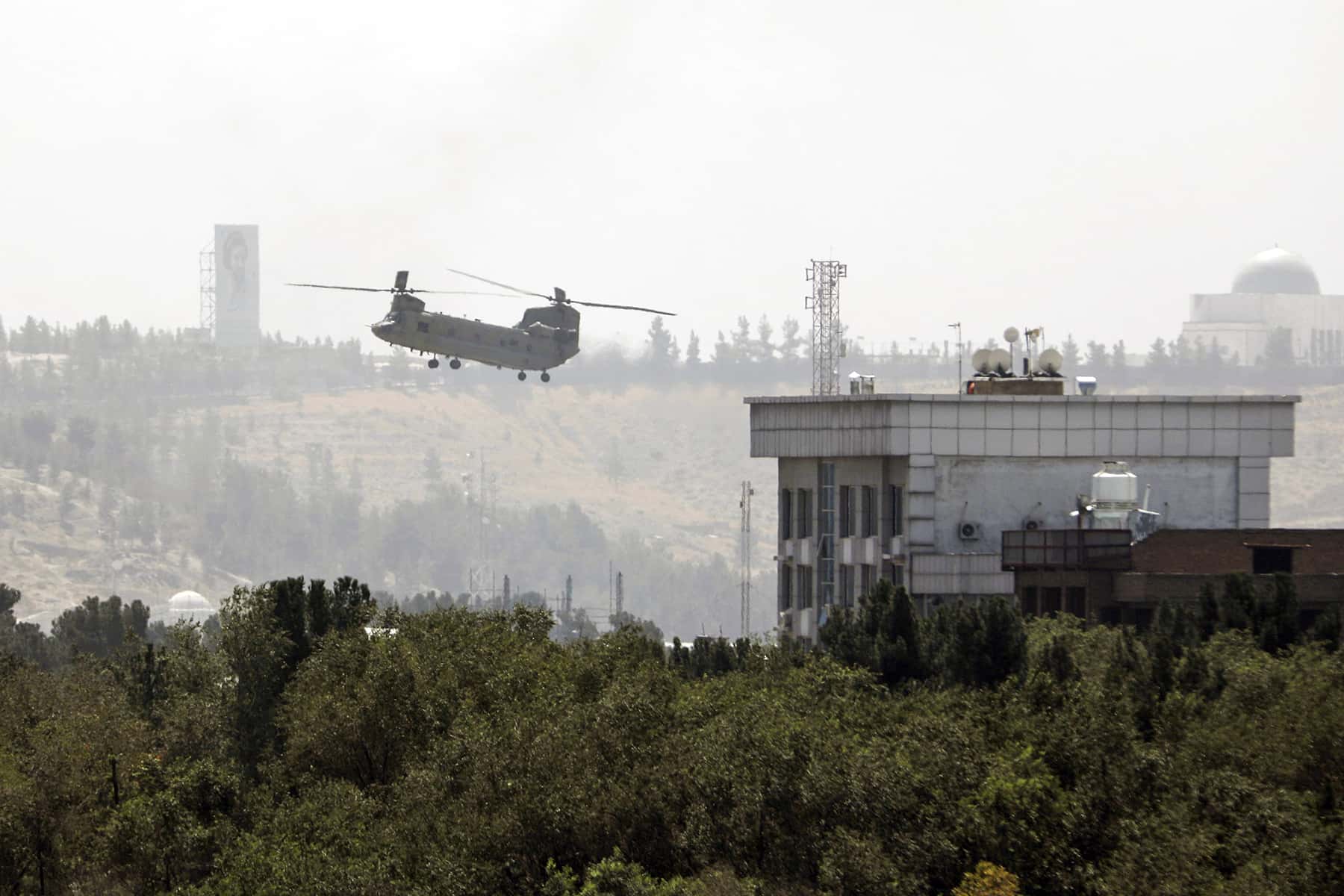
In Afghanistan on August 15, Taliban fighters took over the presidential palace in Kabul, the country’s capital, while the president of the United States-backed Afghan government, Ashraf Ghani, fled to Tajikistan.
The U.S. and many other countries are rushing to evacuate their diplomatic personnel and allies from the country, although Russia is not, as the Taliban has guaranteed their safety. As of that evening, all U.S. embassy personnel are at the Kabul airport, which was being protected by the U.S. military.
Over almost 20 years in Afghanistan, the U.S. has lost 2448 troops and personnel. Another 20,722 Americans have been wounded. The mission has cost more than a trillion dollars.
The U.S. invaded Afghanistan a month after the terrorist attacks of September 11, 2001—which killed almost 3000 people in New York, Virginia, and Pennsylvania—to go after al Qaeda leader Osama bin Laden, who had been behind the attack. The Islamic fundamentalist group that had controlled Afghanistan since 1996, the Taliban, was sheltering him along with other al Qaeda militants. Joined by an international coalition, the U.S. drove the Taliban from power but failed to capture bin Laden, and the War on Terror became a general drive against non-state actors, usually Muslims, who threatened the U.S.
In 2003, President George W. Bush launched another war, this one in Iraq. As the U.S. got bogged down in Iraq, members of the Taliban regrouped in Afghanistan as an insurgent military force that attacked the Afghan government the U.S. had propped up in their place. By 2005, the Taliban had grown powerful enough that officials in the Bush administration worried that the U.S. could fail to undermine them.
President Barack Obama focused again on Afghanistan. In December 2009 he launched a 33,000 troop surge into Afghanistan, bringing the total U.S. deployment there to about 100,000 troops, with an additional 40,000 troops from the North Atlantic Treaty Organization (NATO). In 2011, U.S. Special Forces found bin Laden living in Abbottabad, Pakistan, and killed him in a raid. The next month, Obama announced that he would begin bringing troops home and that the U.S. would leave Afghanistan by 2014. Violence immediately increased, and a new joint security agreement between the U.S. and the Afghan government allowed the U.S. to stay and continue to train Afghan soldiers.
By 2018 the Taliban, which is well funded by foreign investors, mining, opium, and a sophisticated tax system operated in the shadow of the official government, had reestablished itself in more than two thirds of Afghanistan. Americans were tired of the seemingly endless war and were eager for it to end.
To end a military commitment that journalist Dexter Filkins dubbed the “forever war,” former president Donald Trump sent officials to negotiate with the Taliban, and in February 2020 the U.S. agreed to withdraw all U.S. troops, along with NATO allies, by May 1, so long as the Taliban stopped attacking U.S. troops and cut ties with terrorists.
The U.S. did not include the Afghan government in the talks that led to the deal, leaving it to negotiate its own terms with the Taliban after the U.S. had already announced it was heading home. Observers at the time were concerned that the U.S. withdrawal would essentially allow the Taliban to retake control of the country, where the previous 20 years had permitted the reestablishment of stability and women’s rights. Indeed, almost immediately, Taliban militants began an assassination campaign against Afghan leaders, although they did not kill any American soldiers after the deal was signed.
Meanwhile, by announcing their intentions, American officials took pressure off the Taliban to negotiate with Afghan leaders. The Pentagon’s inspector general noted in February that “The Taliban intends to stall the negotiations until U.S. and coalition forces withdraw so that it can seek a decisive military victory over the Afghan government.”
Hoping to win voters with this deal to end the war, the Trump administration celebrated the agreement. In September, Donald Trump Jr. tweeted, “A vote for Joe Biden is a vote for forever war in the Middle East. A vote for Donald Trump is a vote to finally bring our troops home.” Then–Secretary of State Mike Pompeo suggested the U.S. would have “zero” troops left in Afghanistan by spring 2021.
When he was Obama’s vice president, Joe Biden had made it no secret that he was not comfortable with the seemingly endless engagement in Afghanistan. By the time he took office as president in January 2021, he was also boxed in by Trump’s agreement. In April, Biden announced that he would honor Trump’s agreement—“an agreement made by the United States government…means something,” Biden said—and he would begin a final withdrawal on May 1, 2021, to be finished before September 11, the twentieth anniversary of the 9/11 attacks. In July, 73% of Americans agreed that the U.S. should withdraw.
On July 8, Biden announced that the withdrawal was taking place quicker than planned and that the military mission of the U.S. in Afghanistan would end on August 31. He said the U.S. had accomplished what it set out to do in Afghanistan—kill bin Laden and destroy a haven for international terrorists—and had no business continuing to influence the future of the Afghan people. Together with NATO, the U.S. had trained and equipped nearly 300,000 members of the current Afghan military, as well as many more who are no longer serving, with all the tools, training, and equipment of any modern military. While we will continue to support that military, he said, it is time for the Afghan people to “drive toward a future that the Afghan people want and they deserve.”
For those asking that we stay just a little longer, especially in light of the fact the U.S. has lost no personnel since Trump cut the deal with the Taliban, he asked them to recognize that reneging on that deal would start casualties again. And he asked, “Would you send your own son or daughter?”
Biden insisted the U.S. would continue to support the Afghan government and said the U.S. was working to bring to the U.S. Afghan translators whose lives are in danger for working with U.S. forces. He also seemed to acknowledge the extraordinary danger facing Afghan women and girls under the rule of the Taliban as it continues to sweep through the country. And yet, he said, “I will not send another generation of Americans to war in Afghanistan with no reasonable expectation of achieving a different outcome.”
Instead of using troops, Biden has focused on cutting off the flow of money to terrorists through financial and economic sanctions. A U.S. official said that the “vast majority” of the assets of Afghanistan’s central bank are not held in Afghanistan and that the U.S. would freeze whatever assets are in the United States.
As the U.S. pulled out of the country, the Afghan military simply melted away. Regional capitals fell to the Taliban with little resistance, and Kabul today fell with similar ease. Just five weeks after Biden’s July speech, the Afghan president has left the country and the Taliban is in power.
Already, Republicans are trying to blame the Taliban’s success in Afghanistan on Biden, ignoring former president Trump’s insistence that Biden speed up the exit because “getting out of Afghanistan is a wonderful and positive thing to do.” So eager are Republicans to rewrite history that they are literally erasing it. Tonight, Washington Post reporter Dave Weigel noticed that the Republican National Committee has scrubbed from its website a section celebrating the deal the Trump administration cut with the Taliban and praising Trump for taking “the lead in peace talks as he signed a historic peace agreement with the Taliban in Afghanistan, which would end America’s longest war.”
Representative Adam Kinzinger (R-IL), who served in Afghanistan and who opposed Biden’s plan for withdrawal, has been highlighting the past statements of pro-exit Republicans who are now attacking the president. “Do not let my party preten[d] to be outraged by this,” he tweeted. “Both the [Republicans] and [Democrats] failed here. Time for Americans to put their country over their party.”
Rаhmаt Gυl
Letters from an Аmerican is a daily email newsletter written by Heather Cox Richardson, about the history behind today’s politics














